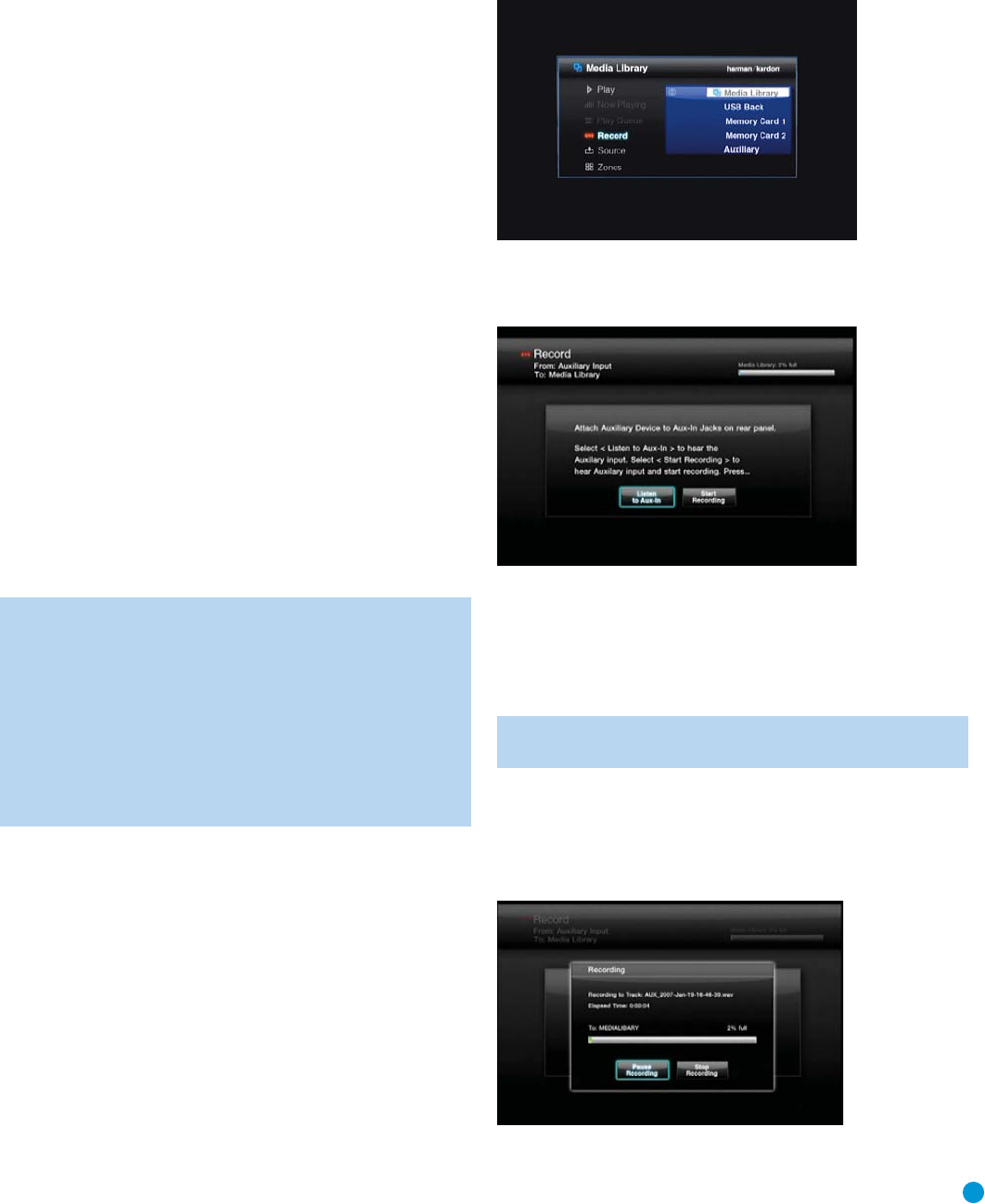
31
OPERATION
The device connected to the Auxiliary Inputs is not available for source
selection in the usual manner. It is selected as a recording source, as
described in the Content Transfer section, although it is possible to
monitor the source without making a recording.
Content Transfer
One of the DMC 1000’s most exciting features is its ability to transfer
content from one type of media to another, and to store your library
of music on its internal hard-disc drive.
The method for making recordings varies slightly, depending on the
source media.
Audio CDs
As soon as an audio CD is loaded, the DMC 1000 begins the process
of copying it to the Media Library at high speed. It displays the progress
of the recording as a percentage recorded.
At the same time, the DMC 1000 automatically begins playing the copy of
the CD from the Media Library, if you have programmed the DMC 1000’s
Setup Menu to do so.
The DMC 1000 uses Gracenote MusicID to identify the CD, tag it with
the correct information and import the album cover art, if available. If the
DMC 1000 is not connected to the Internet, Gracenote MusicID will tag
the content using the offline database stored on the DMC 1000’s hard-
disc drive; however, it will not display any cover art. For homemade discs,
the service will attempt to identify the content based on any tags that were
created when the disc was recorded.
After the DMC 1000 has finished copying the CD to the Media Library,
you may remove the disc and store it.
NOTE: The DMC 1000 initially copies the CD to .wav files.
If you have adjusted the Audio Encoding Quality setting in the
Media Library Setup menu to one of the MP3 formats, the
DMC 1000 will then encode the .wav files as MP3 files at the
specified sampling rate. If you attempt to transfer the CD from
the Media Library to a memory card, recordable CD or USB
drive before the encoding is completed, the files will be transferred
as .wav files. Since .wav files are much larger than MP3 files,
depending on your destination media, you may not have enough
space to complete the transfer.
Data CDs
Data CDs are discs that contain sound and image files. They are recog-
nized when loaded, but operation is handled differently.
To transfer the CD’s content to the Media Library:
1. Select it as a playback source, and view the audio files. Still-image files
may not be added to the Media Library.
2. The CD is listed as a single folder, which you may expand as usual.
Select the Add to Library option to import it to the Media Library.
Audio files are transferred in their original format, e.g., as MP3 files.
Auxiliary Inputs
With the analog audio device connected to the Auxiliary Inputs and
the media loaded, either press the Record Button, or press the Menu
Button to view the Main Menu. Scroll to the Record line and press
the Enter Button.
Select “Auxiliary” from the dropdown menu as the recording source.
See Figure 42.
Figure 42 – Select a Recording Source
Next, select the Media Library (the only option) as the recording destination.
The screen shown in Figure 43 will appear.
Figure 43 – Record From the Auxiliary Inputs
Select the Listen to Aux In option to monitor the analog device. Begin
playing the device, and cue it up to the desired starting point. Example:
most cassette tapes include about five seconds of blank leader tape, plus
additional blank tape at the beginning. Play until the audio begins so as
to minimize the amount of dead air in the recording.
NOTE:
The DMC 1000 does not detect the presence or absence
of an audio signal at the Auxiliary Inputs.
When you are ready to begin the recording, select the Start Recording
option and begin playback of the analog device. You may experiment
by making several recordings and deleting those you don’t want.
While the recording is in progress, a screen similar to the one shown
in Figure 44 will appear.
Figure 44 – Recording in Progress
DMC1000om.qxd 11/30/07 3:59 PM Page 31
